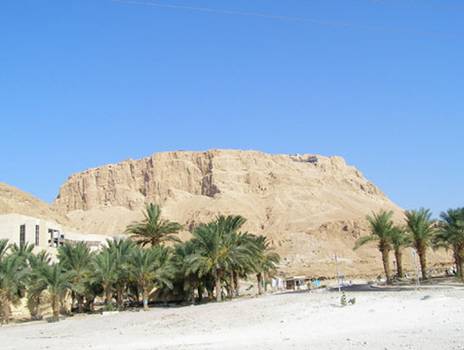

Masada is a archaeological site on top of the large mesa in the South Israel. It is one of the most visited sites in all of Israel.
Location: Map
Masada was build by Herod the Great in the first century BC, but it became most famous for the last stand of Jewish zealots– sicarii after the First Jewish- Roman war of 66- 70 AD that resulted in destruction of the Temple in Jerusalem. Sicarii plural for Sicarius (Latin for “dagger”) is a term given to Jewish insurgents who attacked Romans or Roman sympathizers in Judea. Some scholars suggest that Judas Iscariot in the New Testament was a member of this extremist group hence got its nickname that was altered later. The Snake path that starts at the bottom is hard and long. Recently a tram car was installed to bring the tourists to the top of the 400 meter (1300 feet) plateau. Herod’s palace, baths, Byzantine church from the 5th century and many other sights are well worth the visit of this important cultural and historic symbol of Israel.
The original fortress existed on Masada since the time of the Hasmoneans (167-37 BC). Probably the only time in history then Judaism conversion was forceful dates to late second century BC. Edomites- long time enemies were forced to convert to a new religion. Ironically Herod the Great comes from this nation. Working as a slave in a palace he managed to overthrow the ruling dynasty and become a king. Herod expanded and the fortress on top of Masada and build many structures on top of the plateau. Many structures carry Roman style architecture. Although still a protectorate of Rome, Judea was increasingly Romanized.
In 66 AD at the outbreak of the First Jewish- Roman war (Great Jewish Rebellion) small Roman garrison in Masada was exterminated. After siege and fall of Jerusalem in 70 AD last group of 936 sicarii found refuge here. Although some records indicate that this increasingly violent and extremist group left Jerusalem after quarrel with other Jewish rebels. Despite popular belief, people who were stationed on Masada were not welcome by many Jews. They often attacked their own countrymen who were not patriotic enough and did not resist Romans actively enough. In fact famous Jewish historian Josephus records a sicarii raid on village of Ein- Gedi which resulted in 700 deaths of its citizens.
Roman legion X Fretensis under leadership of governor of Judea Lucius Flavius Silva marched against Masada in 72 AD. Initial attacks did not yield any results thus Romans built several fortresses around the citadel and circumvallation wall to prevent raids from inside the city. Additionally a rampart was constructed to allow battering ram to reach the walls. Thousands of tons of material, reinforced with wooden beams, it still stands today as an incredible feat of engineering. On April 16, 73 AD the walls were breached, but to surprise of Roman commanders only two women with their five children who hid in the water cistern were alive. Sicarii under leadership of Elazar ben Ya’ar (probably the same person as Eleazar ben Simon) chose 10 people to kill everyone. Once most of defenders were killed a single man killed the remaining rebels and finally committed suicide.
Largest and most impressing building in Masada located on three levels. It was divided from the rest of the plateau by a wall with a small entrance. Above a tower was build with soldiers constantly keeping watch. The lowest level of the palace was the banquet hall decorated with columns and frescoes.
Apparently build by Italians this is another example of Herod’s attempt to follow the Roman way of life. It had all the design and features of any prosperous Roman villas: steam room, hot and cold water and palestra (gym court). The columns in the steam room supported the floor and created space for circulation of the hot air from fires burned underneath.
Unlike Northern palace this structure was not a Herod’s living quarter. It was merely used for visitors and official meetings. Judging by remains of cloths and bronze circles, walls could be covered by drapery.
The rock that was used to construct the fortifications, palace, houses and etc was dug right from the plateau. The empty hollow spaces were used as storages for water a rare commodity in the desert. Here according to Josephus two women and five children hid to escape mass suicide.
For a long time the story of Masada was considered to be a myth, however in 1842 it was discovered and archaeological digs supported the popular story. In fact even pottery pieces that were used to choose 10 last men were found. Very little is known of the fate of the bodies. The burial was found with 25 bodies inside, but judging by the pig remains along with human skeletons these belonged to Roman garrison that was stationed on Masada thirty years after its fall.